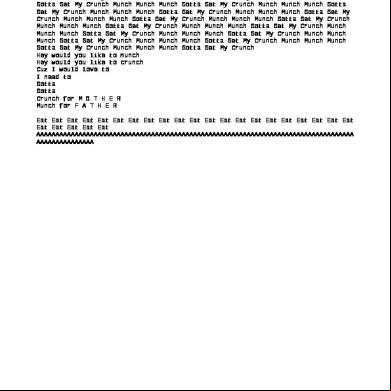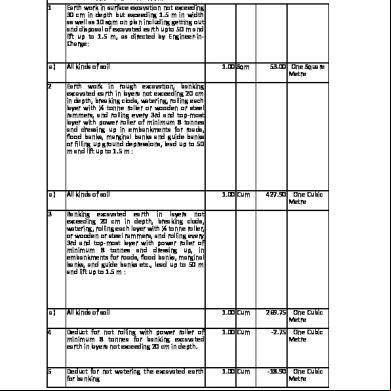Adsasdasd 2if3x
This document was ed by and they confirmed that they have the permission to share it. If you are author or own the copyright of this book, please report to us by using this report form. Report 2z6p3t
Overview 5o1f4z
& View Adsasdasd as PDF for free.
More details 6z3438
- Words: 772
- Pages: 3
1.0 Introduction Curcumin [1, 7-bis (4-hydroxy-3-methoxyphenyl)-1, 6-hepadiene-3, 5-dion] is a major component derived turmeric has received much attention due to its excellent medicinal properties for the past few decades. It is scientifically proven to show medical benefits such as, anti-inflammatory, antimicrobial, anticancer, antioxidant, anti-mutagenic, anti-amyloid, antiAlzheimer, anti-cystic fibrosis, hypoglycaemic and wound healing properties. However, the major drawback of curcumin is low aqueous solubility under acidic condition and it is known to undergo biodegradation under basic conditions. The hydrophobic properties of curcumin making it less feasible to dissolve in aqueous media. It is therefore subjected to poor solubility and lack of bioavailability preventing its effective medicinal properties. Recent development on the drug delivery have proven that the solubility and the bioavailability of curcumin can be improved through encapsulation. Encapsulation of curcumin can promote dispersion in aqueous media and protects from chemical degradation. There are various types of encapsulation employed in industries such as surfactant micelles, nanospheres, nanoparticles, nanoemulsions, liposomes and niosomes. Over the past few years, niosomes have been a great alternative to liposome due to its greater stability, low cost and compability. The structure of the noisome being both hydrophilic and lipophilic enhances various drug delivery. Pure curcumin has different physicochemical and physiological properties from demethoxyand bis-demethoxy-curcumin, which may affect the design of appropriate delivery systems for this nutraceutical. For this reason, pure curcumin was synthesized in the current study and then used to compare the impact of pH on the physical and chemical stability of curcumin in aqueous solutions 2.0 Objective i.
To study the effect of pH on the encapsulation of curcumin in self-assembled noisome curcuminoid.
ii.
To characterize the curcumin in of encapsulation efficiency and stability using thin layer hydration method.
3.0 Materials and Method 3.1 Materials
The rhizomes of Curcuma domestica (Kunyit) is chopped into smaller pieces and air-dried for 2 weeks, and ground into powder in a mill blender before stored in a sealed plastic container.Tween-80(TW-80), chloroform, phosphate buffered saline (PBS), is purchased since it shows better activity. Cholestrol was also obtained and used as a received. 3.2 Niosome preparation Niosome was prepared by thin film hydration method.300μm of cholesterol and Tween-80(1:1) molar ratio were dissolved in chloroform and stirred for 30min.The mixture is then added drop by drop into preheated water at 60oC while stirring continuously to remove organic solvent. After cooling, the residual solvent was evaporated under reduced pressure and constant rotation in a rotary evaporator, to form a thin lipid film. The dry films were then hydrated with PBS or water to obtain niosomes. 3.3 Study on the effect of pH For curcumin encapsulation, 100μM of curcumin was dissolved in chloroform along with cholesterol and Tween 80 for 2h using a vortex. After preparation, the drug (curcumin) loaded niosome aqueous suspension was stored in dark atmosphere at 4 °C and used throughout the experiment. . An aliquot of the stock curcumin solution (4 mM) was diluted in a quartz cuvette (path length 1 cm) with phosphate buffer solution (10 mM; 0.25 g/L KH2PO4, and 1.15 g/L Na2HPO4). HCl and/or NaOH is added to adjust the buffer pH to values ranging from 2.0 to 8.0. Curcumin degradation was determined at room temperature by measuring the change in absorbance at 433 nm over time using an UV−visible spectrophotometer. 3.4. Characterization of niosomes 3.4.1. Morphology The surface morphology of the niosomes, like roughness, shape and size were determined by transmission electron microscopy (TEM). For TEM analysis, a drop of niosome suspension was directly placed on the copper grids and dried over night to remove the moisture completely. The analysis was performed at 200 kV on a field emission TEM. 3.4.2. Size and zeta potential measurements The niosome size, size distribution [polydispersity index (PDI)] and zeta potential were measured by Zetasizer, based on the dynamic light scattering (DLS) technique. 3.4.3. Determination of entrapment efficiency (EE)
After encapsulation, the drug loaded niosomes were first separated by centrifugation at 15,000 rpm for 30 min. Niosomes were then washed twice with water to remove any curcumin present in supernatant. After separation, the pellet obtained was dissolved in ethanol and the encapsulated amount was estimated by UV–Visible spectroscopy at 425nm. The EE % was calculated by the following equation: 𝐸𝐸(%) =
𝐴𝑚𝑜𝑢𝑛𝑡 𝑜𝑓 𝑑𝑟𝑢𝑔 𝑙𝑜𝑎𝑑𝑒𝑑 𝑖𝑛 𝑡ℎ𝑒 𝑛𝑖𝑜𝑠𝑜𝑚𝑒 × 100 𝐼𝑛𝑖𝑡𝑖𝑎𝑙 𝑎𝑚𝑜𝑢𝑛𝑡 𝑜𝑓 𝑡ℎ𝑒 𝑑𝑟𝑢𝑔
3.5. Determination of stability of curcuminoid niosome under processing conditions The effect of different processing conditions like 4oC, 14oC, room temperature and also pH in the range of 3-7 is studied which will be applicable for commercial utilization. The particle size distribution, zeta potential and stability were measured after exposing the curcuminoid niosome to each treatment.
To study the effect of pH on the encapsulation of curcumin in self-assembled noisome curcuminoid.
ii.
To characterize the curcumin in of encapsulation efficiency and stability using thin layer hydration method.
3.0 Materials and Method 3.1 Materials
The rhizomes of Curcuma domestica (Kunyit) is chopped into smaller pieces and air-dried for 2 weeks, and ground into powder in a mill blender before stored in a sealed plastic container.Tween-80(TW-80), chloroform, phosphate buffered saline (PBS), is purchased since it shows better activity. Cholestrol was also obtained and used as a received. 3.2 Niosome preparation Niosome was prepared by thin film hydration method.300μm of cholesterol and Tween-80(1:1) molar ratio were dissolved in chloroform and stirred for 30min.The mixture is then added drop by drop into preheated water at 60oC while stirring continuously to remove organic solvent. After cooling, the residual solvent was evaporated under reduced pressure and constant rotation in a rotary evaporator, to form a thin lipid film. The dry films were then hydrated with PBS or water to obtain niosomes. 3.3 Study on the effect of pH For curcumin encapsulation, 100μM of curcumin was dissolved in chloroform along with cholesterol and Tween 80 for 2h using a vortex. After preparation, the drug (curcumin) loaded niosome aqueous suspension was stored in dark atmosphere at 4 °C and used throughout the experiment. . An aliquot of the stock curcumin solution (4 mM) was diluted in a quartz cuvette (path length 1 cm) with phosphate buffer solution (10 mM; 0.25 g/L KH2PO4, and 1.15 g/L Na2HPO4). HCl and/or NaOH is added to adjust the buffer pH to values ranging from 2.0 to 8.0. Curcumin degradation was determined at room temperature by measuring the change in absorbance at 433 nm over time using an UV−visible spectrophotometer. 3.4. Characterization of niosomes 3.4.1. Morphology The surface morphology of the niosomes, like roughness, shape and size were determined by transmission electron microscopy (TEM). For TEM analysis, a drop of niosome suspension was directly placed on the copper grids and dried over night to remove the moisture completely. The analysis was performed at 200 kV on a field emission TEM. 3.4.2. Size and zeta potential measurements The niosome size, size distribution [polydispersity index (PDI)] and zeta potential were measured by Zetasizer, based on the dynamic light scattering (DLS) technique. 3.4.3. Determination of entrapment efficiency (EE)
After encapsulation, the drug loaded niosomes were first separated by centrifugation at 15,000 rpm for 30 min. Niosomes were then washed twice with water to remove any curcumin present in supernatant. After separation, the pellet obtained was dissolved in ethanol and the encapsulated amount was estimated by UV–Visible spectroscopy at 425nm. The EE % was calculated by the following equation: 𝐸𝐸(%) =
𝐴𝑚𝑜𝑢𝑛𝑡 𝑜𝑓 𝑑𝑟𝑢𝑔 𝑙𝑜𝑎𝑑𝑒𝑑 𝑖𝑛 𝑡ℎ𝑒 𝑛𝑖𝑜𝑠𝑜𝑚𝑒 × 100 𝐼𝑛𝑖𝑡𝑖𝑎𝑙 𝑎𝑚𝑜𝑢𝑛𝑡 𝑜𝑓 𝑡ℎ𝑒 𝑑𝑟𝑢𝑔
3.5. Determination of stability of curcuminoid niosome under processing conditions The effect of different processing conditions like 4oC, 14oC, room temperature and also pH in the range of 3-7 is studied which will be applicable for commercial utilization. The particle size distribution, zeta potential and stability were measured after exposing the curcuminoid niosome to each treatment.







